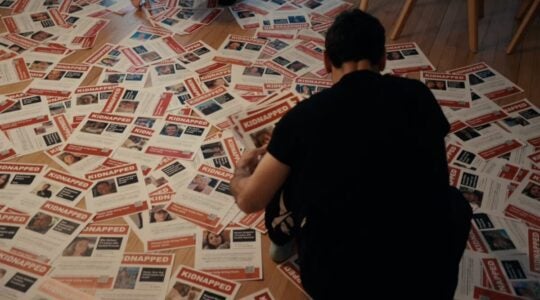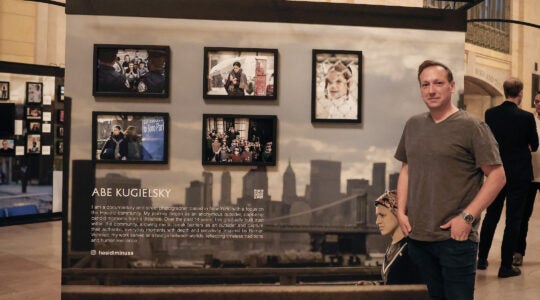LOS ANGELES (JTA) — The place is the Warsaw Ghetto, the year 1942, and the black-and-white footage shows fashionably dressed men and women, with yellow Stars of David as accessories, having a high time at a champagne ball.
Later we see emaciated kids rooting through mounds of garbage and excrement for scraps of food.
The contradictory scenes are from “A Film Unfinished,” an unwitting collaboration between a Nazi propaganda crew and an Israeli filmmaker separated by nearly seven decades.
In May 1942, a German film crew in Wehrmacht uniforms arrived at the Warsaw Ghetto with somewhat vague orders to shoot a documentary on the many aspects of ghetto life in order to show the Jewish “folk” character. Each day a local SS commander nicknamed the “Gold Pheasant” would give the crew its assignments.
After 30 days the German crew disappeared. So did its footage — staged shots alternating with actual street scenes. It was never processed into a film or shown in Germany.
In 1954, four reels were discovered in a vault in East Berlin, left behind by the departing Soviet occupation troops. Filmmakers in subsequent years would extract some of the footage for their projects, showing only the scenes of misery, which became accepted as authentic depictions of ghetto life.
It wasn’t until 1998 that a British filmmaker searching for footage on the 1936 Berlin Olympics at a U.S. Air Force base film vault noticed two cans of film on the floor labeled “Das Ghetto.” The 30 minutes of outtakes showed not only that some scenes had been shot repeatedly by the Germans, but also moments in which the Nazi cameramen accidentally entered into each other’s frames.
That same year, German authorities tracked down and interrogated Willy Wiest, a cameraman on the project.
In 2006, Yael Hersonski, an Israeli television editor and director whose grandmother was a Warsaw Ghetto survivor, started putting together the threads of the story.
Hersonski was attracted to the project for two reasons: her interest in film archives as permanent witnesses to history and the sheer amazement at discovering the Warsaw Ghetto footage.
”After so many years as an Israeli citizen, bombarded with so many films and images that concerned the Jewish Holocaust, I was shocked that I didn’t know anything about this film,” she said.
Hersonski combined the original ghetto scenes with the outtakes to reveal their Nazi origin, adding the testimony of Wiest.
During two years of painstaking research, she said she verified “every document, every page of diary, every archive corridor and staircase shown in the film as the authentic ones, and the languages in which the diaries were written were kept in their origin: Yiddish, Polish and Hebrew.”
For a closing perspective her staff scoured Israel, Poland, England and the United States for Warsaw Ghetto survivors who could recall seeing the German film crew at work. Of the nine that fit the bill, five were willing to watch and comment on the Nazi version of life in the ghetto.
The four women and one man watched the champagne ball patrons dressed up and fed strictly for the occasion. In a “purification” scene, they saw eight young women kidnapped off the street and forced to enter a mikveh naked. The Germans, apparently fascinated by Jewish rituals, painstakingly shot a circumcision, a wedding and the koshering of chickens.
The crew didn’t have to stage manage the grimmer scenes: corpses of children and adults lying in the streets; strapping German soldiers shaking down kids trying to smuggle a few carrots into the ghetto; hand-drawn carts piled high with naked skeletons on their way to a makeshift cemetery.
For Hersonski, 34, this was the most difficult part of the project.
“After each session, I found myself physically numb and mentally knocked out,” she said. “I couldn’t even begin to imagine what the survivors themselves must have felt.”
However agonizing the experience, it may have been the most enlightening, for it showed kernels of truth and reality amid the staged ghetto scenes.
For instance, pedestrians in a number of scenes seemed to walk indifferently past dead children lying unattended on the street. The outtakes showed some of the same pedestrians repeatedly walking past the same point, obviously ordered to do so by the Germans.
One survivor commented that such apparently inhuman callousness existed as a kind of defense mechanism.
“We became indifferent to the suffering of others, otherwise it was impossible to live,” she said.
In another example, while the champagne ball was enacted under Nazi coercion to show the gap between rich and poor, a few dozen ghetto inhabitants had managed to hold on to their money and temporarily were able to enjoy some privileges.
In the end, of course, the rich suffered the same fate as their poorer brethren.
In any case, Hersonski said, “Nobody who wasn’t in a ghetto or concentration camp can judge these people.”
Hersonski is not surprised that a few factual scenes, such as German soldiers stripping starving kids of some smuggled carrots, were included in the footage.
“Propaganda consists not merely of lies,” she said. “The most effective propaganda mixes the lies with a few kernels of truth.”
What did German propaganda minister Joseph Goebbels hope to achieve with the film? And why was it never completed?
Hersonski speculates that Goebbels may have wanted to try something more subtle after the failure of “The Eternal Jew,” which depicted Jews as hordes of voracious rats emerging from a sewer. Although personally supported by Hitler, the film bombed, even in Germany.
“A Film Unfinished” has won major awards at the Sundance Festival, as well as other film festivals in Berlin, Canada and Jerusalem.
Its production was supported by the New Israeli Foundation for Cinema and Television, Yad Vashem Film Project and YES Docu.
(“A Film Unfinished” opens Aug. 18 in New York and Aug. 20 in Los Angeles, followed subsequently by other cities.)
JTA has documented Jewish history in real-time for over a century. Keep our journalism strong by joining us in supporting independent, award-winning reporting.





